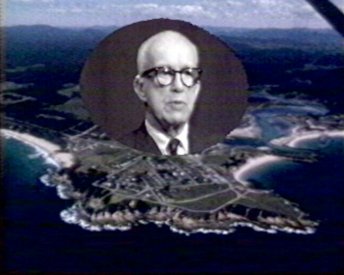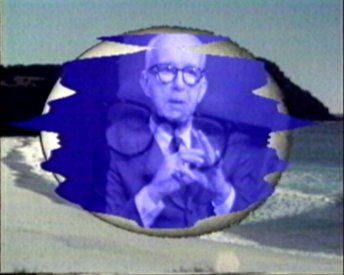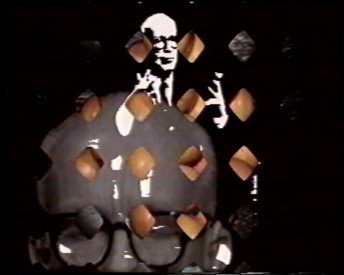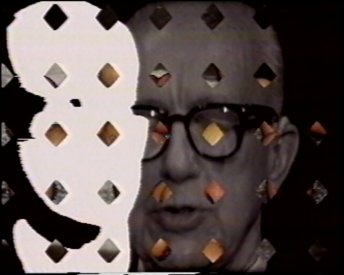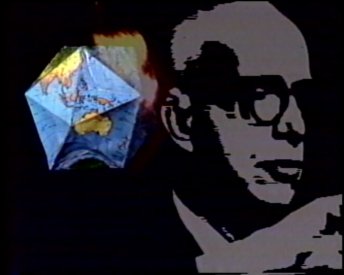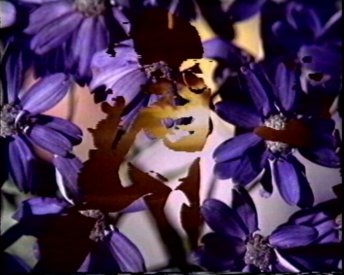Teleologic Telecast from Spaceship Earth.
As has been evident since the beginnings of television in Australia, video production can be more than just edited videotapes and mixed camera sources. With the appearance of colour vision mixers capable of geometric wipes, chroma and luminance keys, multiple layering and other means of compositing images in the very late 1960s – remember colour TV wasn't broadcast in Australia until 1975 – a new kind of production could be made. These used some of the possibilities of film, e.g., the geometric wipes – although in film they were very expensive to make, requiring an optical printer – but with the electronic image processing production capabilities of video/television these effects could be produced quickly and easily in the editing suite, (although it wasn't all that cheap to hire a full broadcast editing suite in 1970).
Mick Glasheen had been experimenting with film since the early 1960s. He could draw in the most intricate detail, was studying architecture at UNSW and had been strongly influenced by experimental filmmakers like Harry Smith, Bruce Connor and Peter Foldes. He had been reading Marshall McLuhan and Gyorgy Kepes and much of his work was influenced by Buckminster Fuller, who visited for the Architecture Students Association in 1965 and 1966. Before Fuller's visit Glasheen had already been making experimental films. In 1964 he produced Who+Lives=Home, influenced by the Dutch humanist architect, Aldo van Eyck, in which he explored the notion that “the home is a large city and the city is a small home”.1
He followed this with The Evolution of 1966, which explored
“the history of the world up until that year. It begins with the number countdown and it goes through man's evolution of numbers and then it goes through the evolution of different technologies, based on Marshall McLuhan's idea about how technologies are extensions of our sense organs and our hands: a cup is an extension of the cupped hand.”2
and then, in 1967, “a 45 minute, three screen 16mm film called “World” which was going to be energy, man, technology.”3
Meanwhile, over that year, Glasheen had devoted his time to reading and researching Fuller's World Design Science proposals. So when it was announced that Fuller was going to be coming out to Sydney again in 1968 for a series of lectures at UNSW, Glasheen wrote to him asking if he could record the talks, to which Fuller assented. Glasheen set up to film the lectures in 16mm but realised that video would be much the better way since he would not have to change rolls of film every few minutes. He arranged with the University AV unit to video the lectures and they borrowed an outside broadcast (OB) van from the University of Sydney TV Service. But, as Glasheen comments, in order to get usable pictures:
“they had to flood the lecture theatre with light, to light the whole … stage just to get this one little figure ... and Bucky was blinded by the light, [which] ruined his lecture really, ruined his empathy with the audience, you know.”4
Because of this they decided that Fuller should give one lecture in the UNSW AV department studio, and it was from this recording of Fuller, in an almost stream of consciousness talk about our place in the universe and how we understand that place, that Glasheen made Teleologic Telecast from Spaceship Earth: On Board with Buckminster Fuller.
Glasheen applied for funding from the Experimental Film Fund of the Australian Council for the Arts to edit and mix a half hour video from the talk, and in July 1970, he received $2000 from its very first round of grants. This allowed him to make arrangements to shoot a great deal of time-lapse footage: sunrises and sunsets, landscape fly-overs and cloudscapes around the northern beaches of Sydney using an intervalometer that Jack Meyer had built for his 16mm Bolex camera.
He enlisted the help of several of his friends, particularly Tom Barber and Jack Meyer, to make models for animation and to produce a sound track. Half the money was used for post-production – telecine transfers and editing – at the Video Tape Corporation (VTC) facilities in Roseville in Sydney in 1970.5 VTC was the first colour television post-production facility in Australia, and had recently acquired a new Richmond Hill vision mixer that allowed a variety of interesting layering and pattern effects. They gave Glasheen 24 hours of “down-time” and showed him what could be done with their new vision mixer, and he then went away and wrote a storyboard of what he wanted.
The final program used an extensive range of the capabilities available in a state of the art TV post-production facility in 1970. These included laser disk slow-motion, reverse-motion and freeze-frames; colour mattes, luminance keying and various kinds of video wipes some of which were modulated by Fuller’s voice. The time-lapse footage and studio recorded material; including a collapsing and reforming tetrahedron of oranges, images of flowers and Fuller’s “dymaxion” globe representation of the earth, were all combined through the electronic effects available on the vision-mixer desk into a collage of time-lapse and real-time images through which Fuller's image, gesturing and talking in an intense stream of ideas about the nature of the universe, science and metaphysics, was layered using modulated wipes and luminance keys. There are even nicely effective small sections of video feedback in this multi-layered collage of image, voice and electronic sound.
Glasheen had analysed Fuller’s lecture into “packages” of different ideas so that an electronic sound track, produced by Jack Meyer using a theremin, could follow the sequence of ideas. Meyer played the theremin in real-time as the videotape played and the sound was recorded to a separate channel on the VTR. It was then mixed down for the kine6 that was printed for exhibition. At that time there was no readily available form of videotape playback for exhibition and, as nearly all theatrettes and similar places in art galleries and film societies were set up with 16mm projection, a kine was the only way to exhibit the work, and this would have been the way most people would have seen Australia’s first independent colour video production.
Teleologic Telecast is an extraordinary video work, full of radical ideas and radical production techniques that clearly expressed Fuller’s ideas of synergy and the ongoing process of the world as a single integrated dynamic system. It also demonstrates the impact of the ideas on the media that McLuhan brought out while being very aware of the recent tradition of experimental film work that Glasheen and particularly Ubu Films had made in Australia. The response from the funders was that their money had been well spent, but the work was clearly not going to be a commercial success. Glasheen did take it to the ABC and Channel 9 but neither of them could accommodate it in their programming.7 However a 10 minute segment from it was shown during the 3rd October 1972 episode of GTK.8
Notes:
Another description of the video is available in a paragraph headed “Bucky Fuller on Video” by Arthur Cantrill in “The Video Revolution” Cantrill’s Filmnotes, no.4, July 1971, p.(7).
References:
1Mick Glasheen, conversation with the author, recorded 14/5/05.
2Ibid
3Ibid
4Ibid
5I believe that VTC was the first colour television production facility in Australia.
6A kine is a film recording of the video image made by a film camera synchronised to the frame rate of the video (here 25 frames per second as opposed to the 24 fps of film).
7Mick Glasheen, conversation with the author, recorded 14/5/05.
8GTK was an acronym for the phrase “Get To Know” and was shown on the ABC most weekday evenings from 1969-1976. It became an important means of getting news about new arts and music out to people throughout Australia. Albie Thoms tells me he interviewed Glasheen and screened Teleological Telecast on GTK in 1975, so this 1972 date, derived from the GTK list compiled by ABC archives might be incorrect. [Thoms: email 3 May, 2006]
